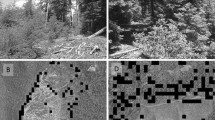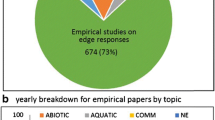Abstract
Ecologists understand the world as a seamless fabric in space and time and are fond of saying that everything is connected to everything else. They also know, however, that said fabric is not homogeneous nor necessarily changing only gradually. Discontinuities are rampant, and so we have “things” defined by those discontinuities or boundaries. Habitat edges are one such type of discontinuity. These edges are critical features in the life of organisms and are essential components to our understanding of how they respond to habitat heterogeneity (Lidicker and Koenig 1996). Although edges have always been important in the functioning of the biosphere, their prevalence is accelerating in a world increasingly dominated by anthropogenic influences.
Access this chapter
Tax calculation will be finalised at checkout
Purchases are for personal use only
Preview
Unable to display preview. Download preview PDF.
Similar content being viewed by others
Literature Cited
Andreassen, H.P., S. Halle, and R.A. Ims. I 996a. Optimal width of movement corridors for root voles: Not too narrow and not too wide. Journal of Applied Ecology 33: 63–70.
Andreassen, H.P., R.A. Ims, and O.K. Steinset. 1996b. Discontinuous habitat corridors: effects on male root vole movements. Journal of Applied Ecology 33: 555–560.
Andreassen, H.P., K. Hertzberg, and R.A. Ims. 1998. Space use responses to habitat fragmentation and connectivity in the root vole Microtus oeconomus. Ecology 79: 1223–1235.
Berg, K.W. 1995. Space use responses of root voles (Microtus oeconomus) to a habitat fragmentation gradient. M.S. Thesis, University of Oslo, Oslo, Norway.
Bowers, M.A., K. Gregario, C.J. Brame, S.F. Matter, and J.L. Dooley, Jr. 1996. Use of space and habitats by meadow voles at the home range, patch and landscape scales. Oecologia 105: 107–115.
Collins, R.J. and G.W. Barrett, 1997. Effects of habitat fragmentation on the meadow vole (Microtus pennsylvanicus) population dynamics in experiment landscape patches. Landscape Ecology 12: 63–76.
Duelli, P., M. Studer, I. Marchand, and S. Jakob. 1990. Population movements of arthropods between natural and cultivated areas. Biological Conservation 54: 193207.
Forman, R.T.T., and P.N. Moore. 1992. Theoretical foundations for understanding boundaries in landscape mosaics. Pages 236–258 in A.J. Hansen and F. di Castri, editors. Landscape boundaries, consequences for biotic diversity and ecological flows. Ecological Studies Vol. 92, Springer-Verlag, New York, New York.
Hansen, A.J., and F. di Castri (editors). 1992. Landscape boundaries, consequences for biotic diversity and ecological flows. Ecological Studies Vol. 92, Springer-Verlag, New York, New York.
Hansen, A.J., P.G. Risser, and F. di Castri. 1992. Epilogue: biodiversity and ecological flows across ecotones. Pages 423–438 in A.J. Hansen and F. di Castri, editors. Landscape boundaries, consequences for biotic diversity and ecological flows. Ecological Studies Vol. 92, Springer-Verlag, New York, New York.
Heske, E.J. 1995. Mammalian abundances on forest-farm edges versus forest interiors in southern Illinois: is there an edge effect? Journal of Mammalogy 76: 562–568.
Johnston, C.A., J. Pastor, and G. Pinay. 1992. Quantitative methods for studying landscape boundaries. Pages 107–125 in A.J. Hansen and F. di Castri, editors. Landscape boundaries, consequences for biotic diversity and ecological flows. Ecological Studies Vol. 92, Springer-Verlag, New York, New York.
Kenward, R. 1987. Wildlife radio tagging: equipment, field technique and data analysis. Academic Press, London, United Kingdom.
Leopold, A. 1933. Game management. Charles Scribner’s Sons, New York, New York.
Lidicker, W.Z., Jr. 1976. Experimental manipulation of the timing of reproduction in the California vole. Researches on Population Ecology 18: 14–27.
Lidicker, W.Z., Jr. 1979. Analysis of two freely-growing enclosed populations of the California vole. Journal of Mammalogy 60: 447–466.
Lidicker, W.Z., Jr. 1988. Solving the enigma of microtine “cycles.” Journal of Mammalogy 69: 225–235.
Lidicker, W.Z., Jr. 1995a. The landscape concept: something old, something new. Pages 3–19 in W.Z. Lidicker, Jr., editor. Landscape approaches in mammalian ecology and conservation. University of Minnesota Press, Minneapolis, Minnesota.
Lidicker, W.Z., Jr. (editor). 1995b. Landscape approaches in mammalian ecology and conservation. University of Minnesota Press, Minneapolis, Minnesota.
Lidicker, W.Z., Jr., and W. D. Koenig. 1996. Responses of terrestrial vertebrates to habitat edges and corridors. Pages 85–109 in D.R. McCullough, editor. Metapopulations and wildlife conservation. Island Press, Washington, D.C.
Lidicker, W.Z., Jr., J.O. Wolff, L.N. Lidicker, and M.H. Smith. 1992. Utilization of a habitat mosaic by cotton rats during a population decline. Landscape Ecology 6: 259–268.
Mills, L.S. 1996. Fragmentation of a natural area: dynamics of isolation for small mammals on forest remnants. Pages 199–218 in R.G. Wright, editor. National parks and protected areas: their role in environmental protection. Blackwell Science Publications, Cambridge, Massachusetts.
Murcia, C. 1995. Edge effects in fragmented forests: implications for conservation. Trends in Ecology and Evolution, 10: 58–62.
Odum, E.P. 1971. Fundamentals of ecology. W.B. Saunders Company, Philadelphia, Pennsylvania.
Peterson, J.A. 1996. Gray-tailed vole population responses to inbreeding and environ mental stress. Ph.D. Dissertation, University of California, Berkeley, California.
Smith, T.B., R.K. Wayne, D.J. Girman, and M.W. Bruford. 1997. A role for ecotones in generating rainforest biodiversity. Science 276: 1855–1857.
Stamps, J.A., M. Buechner, and V.V. Krishnan. 1987. The effects of habitat geometry on territorial defense costs: intruder pressure in bounded habitats. American Zoologist 27: 307–325.
Wiens, J.A. 1992. Ecological flows across landscape boundaries: a conceptual view. Pages 217–235 in A. J. Hansen and F. di Castri, editors. Landscape boundaries, consequences for biotic diversity and ecological flows. Ecological Studies Vol. 92, Springer-Verlag, New York, New York.
Wiens, J.A., C.S. Crawford, and J.R. Gosz. 1985. Boundary dynamics: a conceptual framework for studying landscape ecosystems. Oikos 45: 421–427.
Wolff, J.O., and E.M. Schauber. 1996. Space use and juvenile recruitment in gray-tailed voles in response to intruder pressure and food abundance. Acta Theriologica 41: 3543.
Wolff, J.O., E.M. Schauber, and W.D. Edge. 1996. Can dispersal barriers really be used to depict emigrating small mammals? Canadian Journal of Zoology 74: 1826–1830.
Wolff, J.O., E.M. Schauber, and W.D. Edge. 1997. Effects of habitat loss and fragmentation on the behavior and demography of gray-tailed voles. Conservation Biology 11: 945–956.
Editor information
Editors and Affiliations
Rights and permissions
Copyright information
© 1999 Springer Science+Business Media New York
About this chapter
Cite this chapter
Lidicker, W.Z., Peterson, J.A. (1999). Responses of Small Mammals to Habitat Edges. In: Barrett, G.W., Peles, J.D. (eds) Landscape Ecology of Small Mammals. Springer, New York, NY. https://doi.org/10.1007/978-0-387-21622-5_10
Download citation
DOI: https://doi.org/10.1007/978-0-387-21622-5_10
Publisher Name: Springer, New York, NY
Print ISBN: 978-1-4757-5640-1
Online ISBN: 978-0-387-21622-5
eBook Packages: Springer Book Archive




